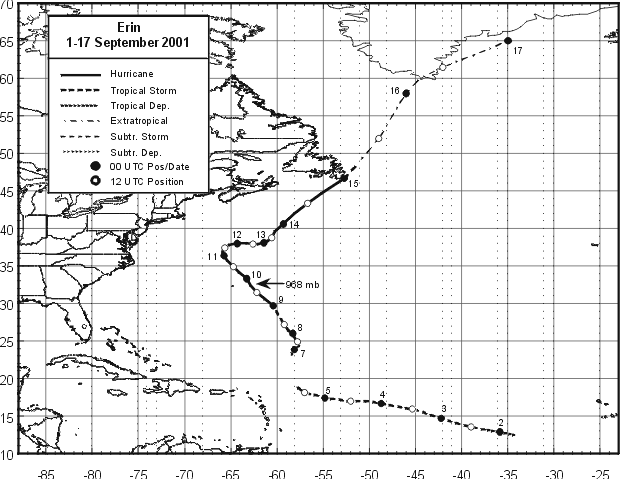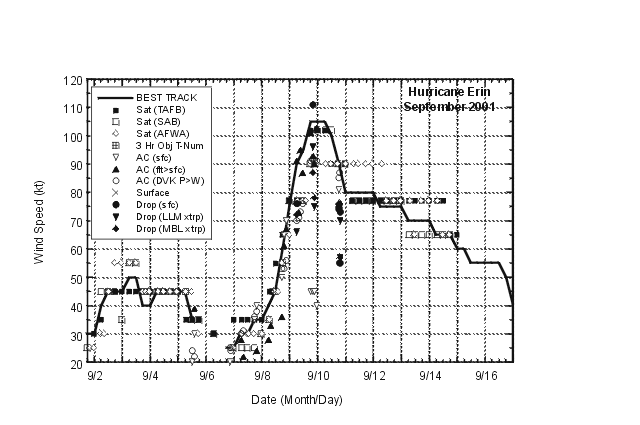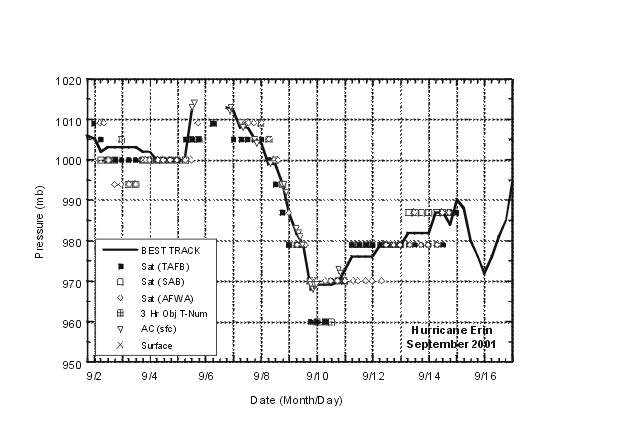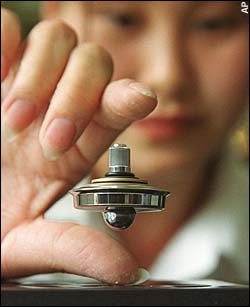 |
|
| (Original figure from source.) | |
| Figure 1: Best track for Hurricane Erin, September 2001. Track during the extratropical stage is based on analyses from the NOAA Marine Prediction Center. Source: |
Figure 1x: Best track for Hurricane Katrina, August 2005. Track during the extratropical stage is based on analyses from the NOAA Marine Prediction Center. Source: Katrina_p37_75.jpg, Katrina_p37_150.jpg, Katrina_p37_300.jpg http://www.nhc.noaa.gov/pdf/TCR-AL122005_Katrina.pdf |
|
click on images for enlargements.
|
 |
|
| (Original figure from source.) | |
| Figure 2: Best track maximum sustained surface wind speed curve for Hurricane Erin, September 2001, and the observations on which the best track curve is based. Aircraft observations have been adjusted for elevation using 90%, 80%, and 80% reduction factors for observations from 700 mb, 850 mb, and 1500 ft, respectively. Dropwindsonde observations include actual 10 m winds (sfc), as well as surface estimates derived from the mean wind over the lowest 150 m of the wind sounding (LLM), and from the sounding boundary layer mean (MBL). Estimates during the extratropical stage are based on analyses from the NOAA Marine Prediction Center. Source: |
Figure 2x: Best track maximum sustained surface wind speed curve for Hurricane Katrina, August 2005, and the observations on which the best track curve is based. Source: TCR-AL122005_Katrina38_75.jpg, TCR-AL122005_Katrina38_150.jpg, TCR-AL122005_Katrina38_300.jpg http://www.nhc.noaa.gov/pdf/TCR-AL122005_Katrina.pdf |
 |
|
| (Original figure from source.) | |
| Figure 3: Best track minimum central pressure curve for Hurricane Erin, September 2001, and the observations on which the best track curve are based. Estimates during the extratropical stage are based on analyses from the NOAA Marine Prediction Center. Source: |
Figure 3: Best track minimum central pressure curve for Hurricane Katrina, August 2005, and the observations on which the best track curve are based. Estimates during the extratropical stage are based on analyses from the NOAA Marine Prediction Center. Source: TCR-AL122005_Katrina39_75.jpg, TCR-AL122005_Katrina39_150.jpg, TCR-AL122005_Katrina39_300.jpg |
|
|



